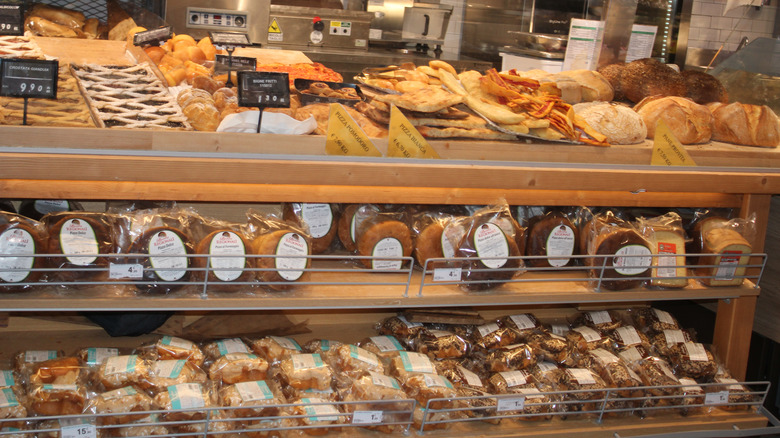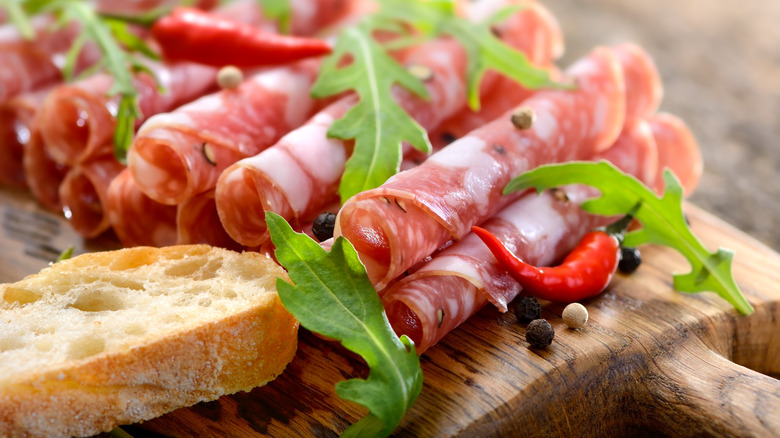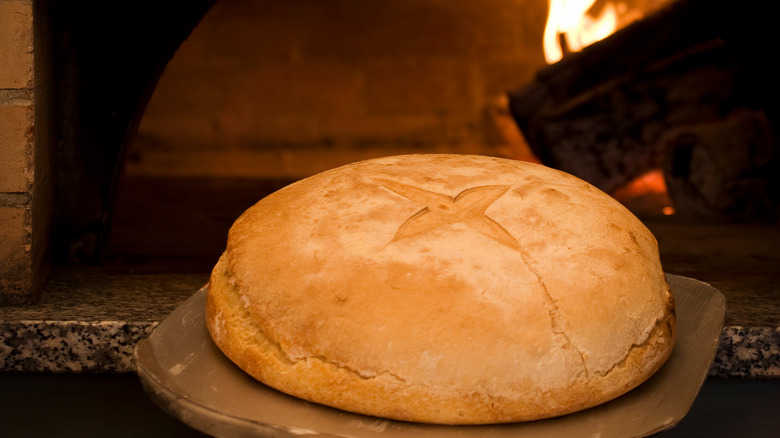The Italian 'Cardboard' Tasting Bread To Avoid Eating On Its Own, Per Stanley Tucci
On "Searching for Italy," which may be one of the 50 best travel shows of all time, Stanley Tucci gives all kinds of Italian cuisine a moment in the spotlight. However, that doesn't mean he likes everything he samples. On the Season 1 episode titled "Tuscany," he says of the region's signature bread, "It actually tastes like cardboard."
Many would probably agree with Tucci that, on its own, Tuscan bread is pretty flavorless, mainly because it lacks salt. Saltless breads are common in several other regions of Italy, including Umbria, Lazio, and Le Marche, and why this is so remains a gastronomic mystery. In a land that prides itself on its cuisine, how did such bland bread ever pass muster?
There are a few different hypotheses about why some Italians stopped salting their bread dough. One is that residents in certain areas (particularly around Perugia) refused to buy salt as an act of rebellion against Pope Paul III, who enacted a salt tax in the 1500s to fatten his coffers. Another theory claims that an intercity dispute in the 13th century led to Pisa blocking salt shipments to nearby Florence, causing salt shortages in Tuscany and forcing people to make do without. However, the most plausible explanation may be the simplest. Centuries ago, Italian peasants only baked bread once per week and may have stopped salting bread to make it last a little longer, as unsalted bread retains less moisture and doesn't mold as quickly.
The right way to eat Tuscan bread
As you're likely to encounter this unsalted bread in Tuscany's many must-visit spots, here are a few ways to approach it. First, it pairs wonderfully with other staple foods from the region, many of which are quite salty on their own. This includes foods like cured meat, tangy game, pecorino cheese, and savory legume soups and stews. When paired with the right prosciutto or salami, the bread transforms from a dull wafer to a magic carpet, which can deliver food to the palate without taking too much from the meat's striking flavor. Secondly, the dry bread also makes a wonderful scarpetta(which translates to "little shoe") for soaking up final bits of olive oil, soup, or sauces, ensuring that no drops go to waste.
Third, in the aforementioned "Searching for Italy" episode, Stanley Tucci notes that his preferred way to eat Tuscan bread is buried in some of the region's tastiest dishes: "I have to admit that I much prefer Tuscan bread cooked in dishes ... because on its own it can taste quite bland – and that's an understatement." One of these dishes is ribollita, a hearty white bean soup that's served poured over pieces of stale Tuscan bread. Other dishes that beautifully incorporate the bread are pappa al pomodoro (tomato and bread soup) and panzanella (tomato and bread salad). If you've tried these local dishes, you've already experienced the ability of this neutral bread to blend with other ingredients without overpowering them, supporting their unique flavors and textures.
Where to find Italy's best bread
Stanley Tucci said in an interview with CNN Travel that one of the key things to know about food in Italy is how wildly it varies from place to place. Now that we know what to expect from our bread basket in Tuscany, where in the country can we go to find more savory types of bread? Some would say Italy's best bread is to be found in Puglia, particularly in the town of Altamura, near Bari. Carb lovers from peasants to nobles have been obsessed with Altamura's loaves for thousands of years, with the Latin poet Horace describing it in 37 B.C. as "by far the best bread to be had, so good that the wise traveller takes a supply with him for his onward journey," per Great Italian Chefs.
The bread may not just be the best in Italy, but maybe even all of Europe. Currently, it's the only European bread with Protected Designation of Origin status, meaning that any loaf classified as Pane di Altamura DOP must use a specific kind of wheat and adhere to the traditional recipe and baking methods. This ensures that the final product, which Horace raved about in Roman times and foodies still drool over today, will endure in perpetuity. The hallmarks of this renowned bread are its thick crust, yellow, spongy center, chewy texture, and tangy, nutty flavor. Try it for yourself when touring the south of Italy, and prepare to fall in love.


